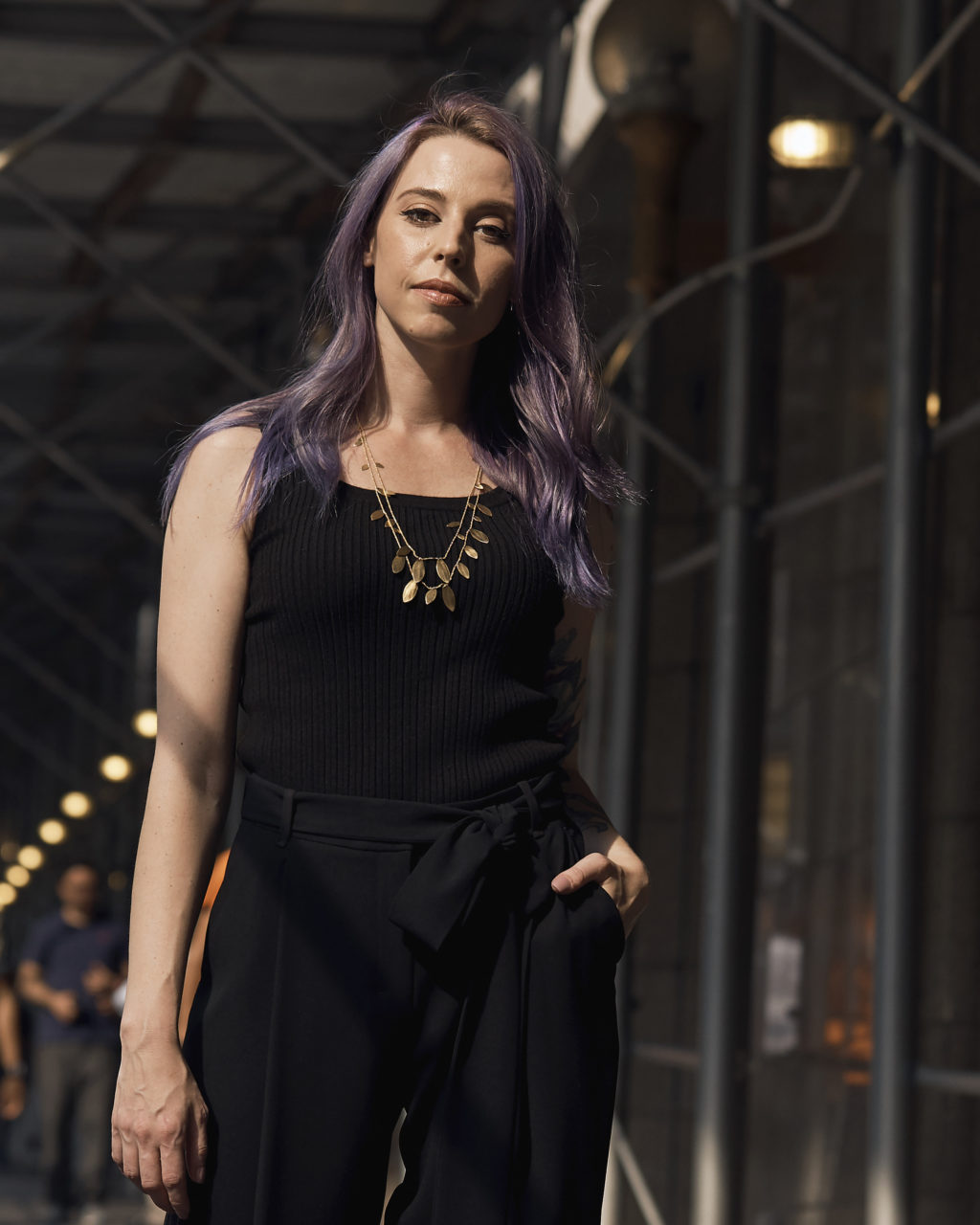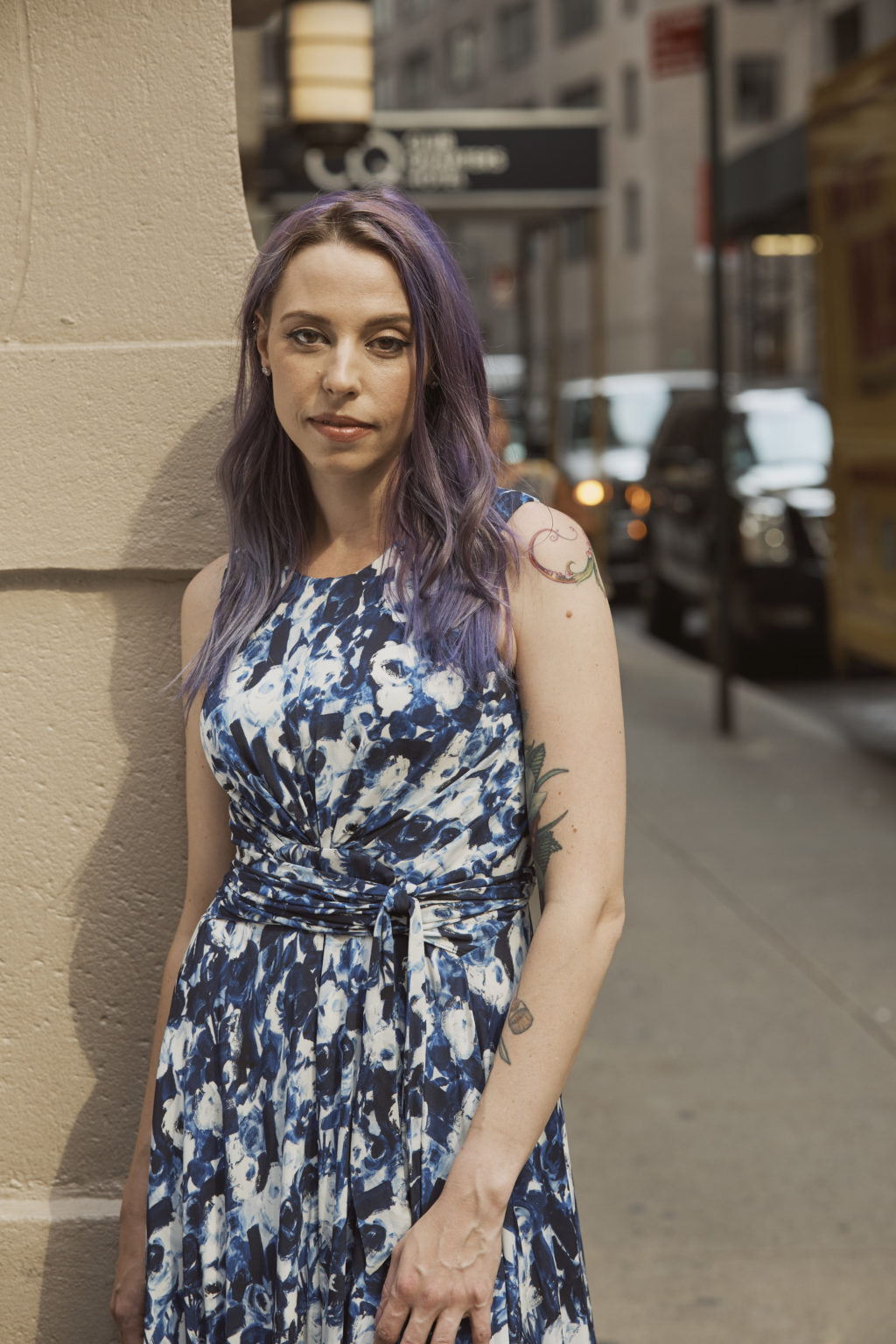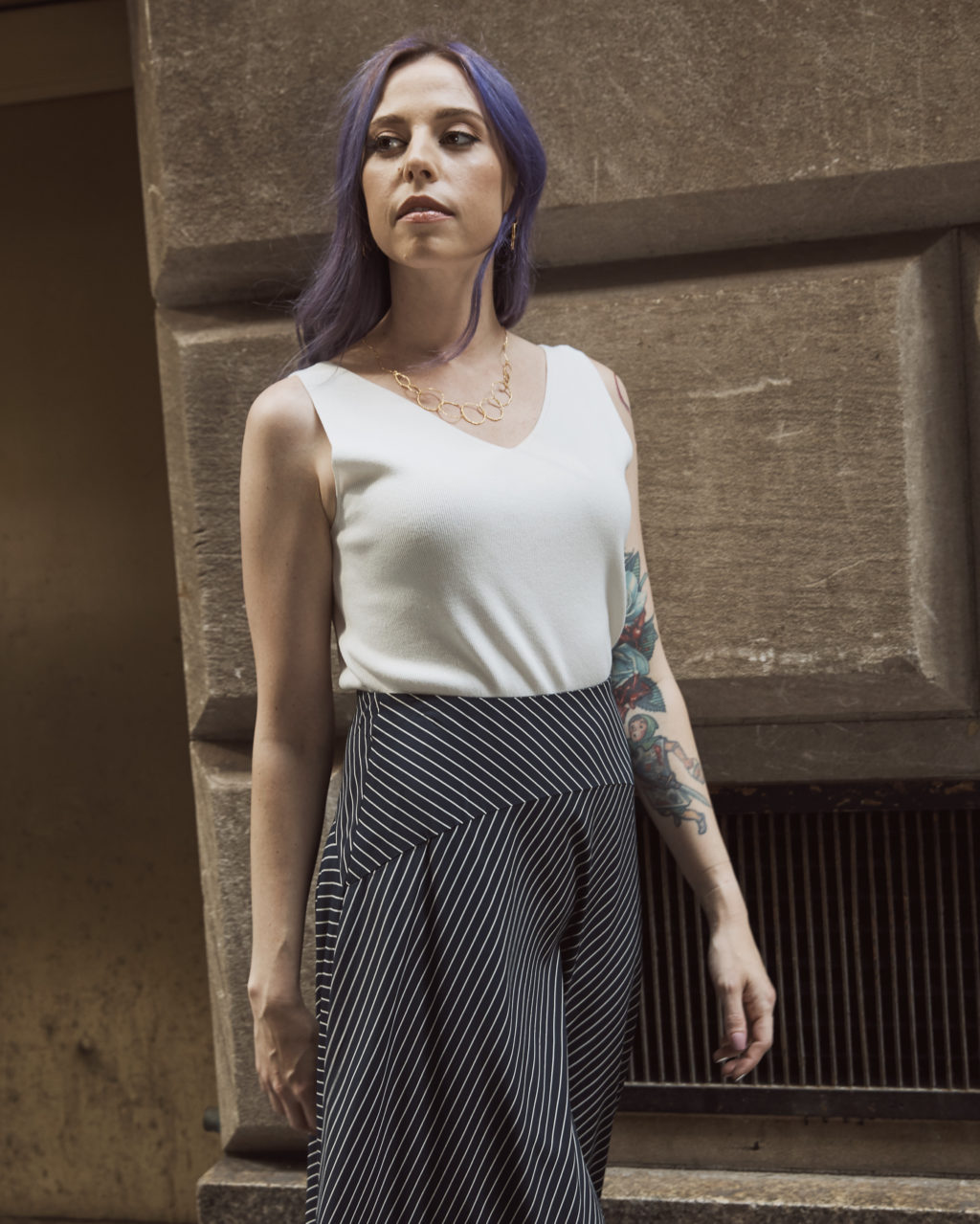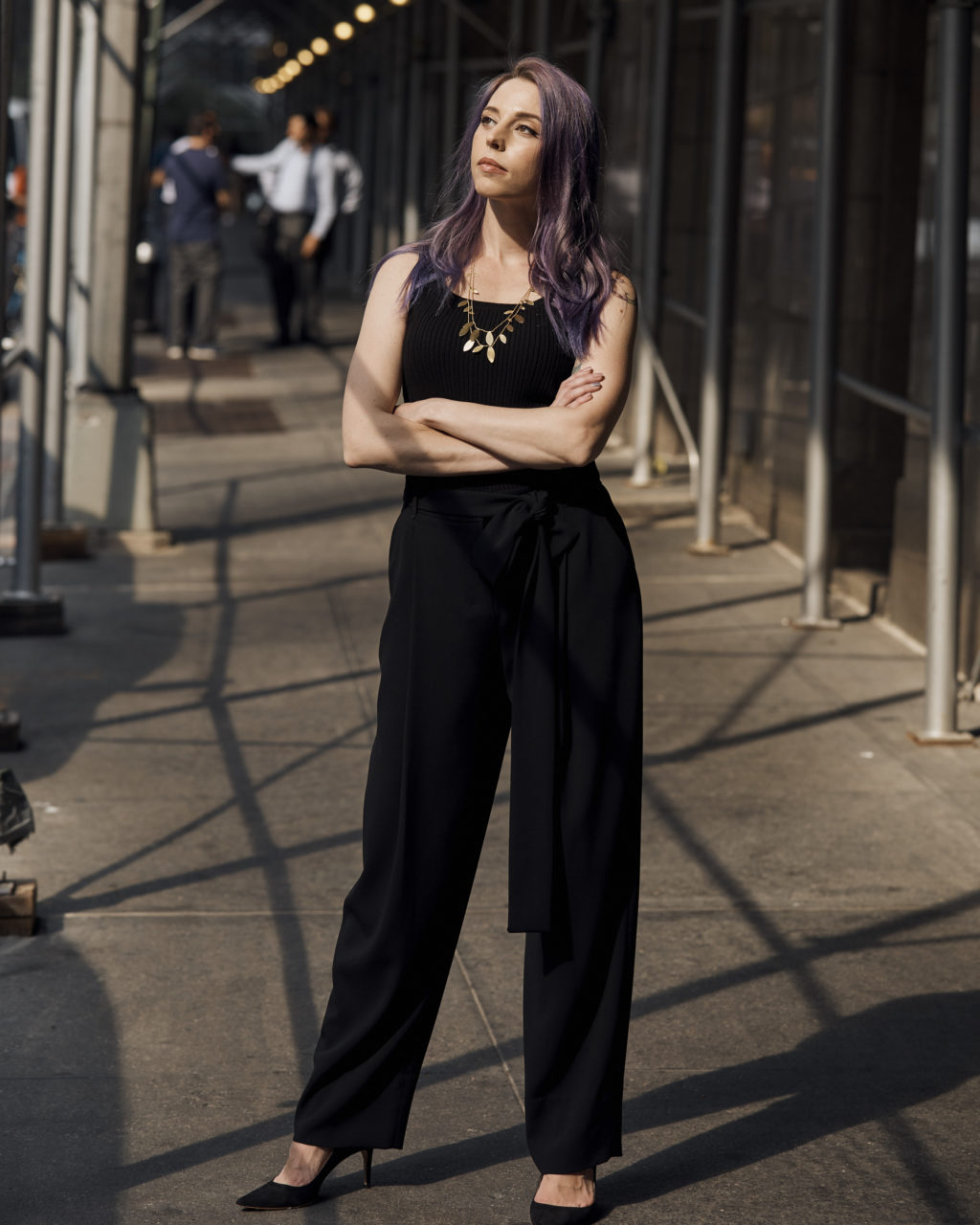Clovyr’s Amber Baldet: “You Should Not Have to Adopt a Specific Brand of Femininity to be Valuable”
August 31, 2018 | Filed in: Woman of the Week
This past April, Amber Baldet left her executive director job at JPMorgan Chase to co-found Clovyr, a Brooklyn-based startup that helps consumers and businesses tap into the possibilities of blockchain technology. It’s a bold move for someone who’s spent the past decade in corporate finance, but then again, Baldet isn’t one for coloring inside the lines. Take, for example, her lavender hair and multiple tattoos—not exactly standard fare on Wall Street. And then there’s her background: Raised in Florida by an English teacher and a drama professor, she’s a hacker-slash-banker (or banker-slash-hacker?) who rose from trading assistant to build some of the most revolutionary tech tools in the finance world. (Not to mention, of course, that she’s a rare female leader in two notorious boys’ clubs, tech and finance—or three, if you count startups.) Here, she talks about being the only woman in the room, finding her hacker community, and how she learned to command an audience.
I’M FROM SOUTH FLORIDA, and I grew up in the era when the internet was becoming mainstream. I was in middle school when AOL got big, but I had already been on the internet for a while before that. My dad had a personal computer in the ‘80s, so I’d been doing things on the command line since I was about five or so. I didn’t realize that other girls around me didn’t have that same exposure, but neither did most of the boys. Computers only became a “boy” thing in the late ‘80s and early ‘90s, when video game culture started and movies like War Games came out. Before that, in most of the ‘60s and ‘70s, computer work was mostly done by women, because it was considered a repetitive task. By the time computers became equated with boys, I had already been using them for a number of years.

Amber wears the Peggy top in ivory, the Winthrop skirt in diagonal stripe, the Oberon earrings, and the Helene necklace.
WHEN I FIRST MOVED TO NEW YORK, I figured that the best way to look serious was to have the diametrical opposite of the long, blonde hair I’d had in Florida, so I dyed it jet black and cut it off. I have a very malleable appearance, and it’s absolutely true that people treat you differently based on how you look.
I GREW UP FLIPPING THROUGH MY MOM’S BOOKS of 1940s glamour stars, like Katharine Hepburn and Hedy Lamarr, who invented frequency hopping. She was considered one of the most beautiful women in the world, and even though frequency hopping was used in World War II, her patents were never really monetized because people thought she was too pretty to invent these things. It sucks that we’ve told women, “You have to wear a lab coat and no makeup to be taken seriously.” It’s as bad as telling them, “You need to wear lipstick and this kind of dress to be considered attractive.” You’re damned if you do, damned if you don’t. I love the idea that you should not have to adopt a specific brand of femininity in order to be valuable.

Amber wears the Helen top and the Flynn trouser in black with the Pomona necklace.
IN MY TEENS, MY HEROES were Dana Scully from The X-Files and Angelina Jolie’s character in Hackers. I was interested in how computing was starting to impact international politics, and that led me to focus more on information security. At the same time, it was very important for me to be able to blend in. I wasn’t in computer club in high school. I didn’t want to get picked on, so I was a cheerleader. But I think the idea that there’s a big difference between jocks and computer nerds is sort of a trope. The truth is, I was interested in a lot of different things, and so were most of my friends. I took AP Calculus and Chemistry, and I graduated as one of the top 10 students in my class. I was also into drama and musicals. I pursued computer stuff mostly on my own time. I taught myself to build early web applications, and I did experiments with fiber optics for science fair projects.
I WENT INTO FINANCIAL SERVICES AFTER COLLEGE. When I moved to New York, I worked at a hedge fund for a little while, supporting the trading desk. But it’s a general computer science axiom that if you have to do something more than twice, you should automate it, so I very quickly started building computer tools for the trading desk and back office systems. I hate inefficiency and human error, and if you just automate things, it can fix a lot of problems. Eventually, I moved out of the front office and became an application developer in financial technology.

Amber wears the Hanna dress in floral crêpe and the Pave earrings.
I’D HAD HACKER FRIENDS IN FLORIDA, but it wasn’t until I moved to New York that I became part of a larger community. At the time, Maker culture was becoming a thing, and it was an interesting crossover between hackers and artists. We’d get together to play with 3D printers and LED lights, and that was really fun. I’ve always enjoyed sewing things and making costumes—Halloween is my favorite holiday—and this brought those diverse skill sets together. It’s also how I met some really talented people.
LEFT TO MY OWN DEVICES, I’M HAPPY TO DRESS for the cyber apocalypse—a black hoodie and pants—but when I started out in banking, I wore mostly suits. Then, when I was promoted to executive director [at JP Morgan], I noticed that a lot of the senior women around me had their own power fashion looks; they weren’t just wearing suits all the time. I don’t really have the time or inclination to figure out that kind of style on my own, and that’s when I discovered MM.LaFleur and the Bento Box. I was like, “Great! I can outsource this fashion expertise that I need to appear the way I want!” There’s a certain privilege that comes with fitting in just enough, and it requires a lot of nuance in how you dress and act. It’s nice to have at least one shortcut to get through that every day.

Amber wears the Peggy top in ivory, the Winthrop skirt in diagonal stripe, the Oberon earrings, and the Helene necklace.
IT WAS A CHALLENGE TO TRANSITION into management positions, but I got all the Harvard Business Review books and threw myself into figuring out how to be good at it. I also took note of women and men who could really command a room, and paid attention to their mannerisms. Then I tried on some of those affectations, and found that some of them fit me and some of them didn’t. It’s important to recognize that, as a conventionally attractive, cis-female-presenting white woman, I have a certain amount of privilege. If, for example, I was a woman of color with a foreign accent, I may have had a harder time emulating certain behaviors, because people would have perceived them differently. Of course, none of us should have to worry about these factors, but it’s important to acknowledge that they exist. The idea that we can create some sort of future where everyone can be their authentic selves all the time and everything’s going to be peaches—it doesn’t seem very realistic to me. At least not yet.
I DISLIKE THE IDEA that being alpha or aggressive is a masculine quality, and I equally dislike the idea that we need to all be masculine or aggressive in order to succeed. Those things are not true. But if that’s the way I need to act to survive in a certain setting, I’ll do it. Now that I’m starting my own company, I want to build a more compassionate organization where that isn’t necessary.

Amber wears the Helen top and the Flynn trouser in black with the Pomona necklace.
THE WORLD OF BLOCKCHAIN TECHNOLOGY is still quite young. In some ways, it’s like being in the early ’90s of the internet again; some of the choices that we make right now will impact how people use this technology in 20 or 30 years. My co-founder and I have a vision of how things should be, and he convinced me that we could build a company that other people would want to be a part of. The ability to have that kind of impact was tough to resist.
OUR COMPANY, CLOVYR, BUILDS TOOLS that help people create decentralized applications, or platforms that are not controlled by a single entity. For example, Twitter is a platform where many people can talk to each other, but Twitter as an organization has a lot of control over what gets read and who can have an account. Decentralized alternatives can provide the same functions but without the central intermediary. Pretty much all the applications we use today are centralized in some way—there’s somebody who runs the show. At Clovyr, we are experimenting with ways to build different types of business models that challenge that hegemony, and allow people to make better choices about how we engage with each other. It’s also about increasing agency and consent in how our data is used.

Amber wears the Hanna dress in floral crêpe and the Pave earrings.
THE TIMES WHEN I STRUGGLE THE MOST are when I feel like I’m succeeding, or have my bearings, and then somebody throws that into question. For example, I was at a workshop for organizational and technical design a couple of years ago, and during a group discussion, I grabbed a marker to help people jot notes down on the board. I wasn’t leading the conversation, but I was chipping in. I left the workshop feeling energized and like I was going to get to contribute a lot. Then, when I got outside, a man pulled me aside and said, “I wanted to let you know that when you were writing on the board, some of the men in the room were rolling their eyes behind your back. You need to establish credibility before you step up to lead.” I’m now 100 percent sure that he was the only person rolling his eyes, but at the time, I felt so deflated. I said, “If you think this is the first time I was in a room with forty men and two of them rolled their eyes behind my back, you’d be mistaken.” And then I achieved a lot of things at the workshop and was elected to a variety of positions within the organization. Still, those moments are frustrating.
Photographs by Jeff Allen.





